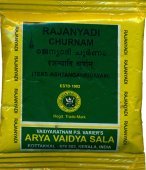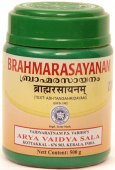Rajani, Rajanī, Rājanī: 29 definitions
Introduction:
Rajani means something in Hinduism, Sanskrit, Buddhism, Pali, Marathi, Hindi, biology. If you want to know the exact meaning, history, etymology or English translation of this term then check out the descriptions on this page. Add your comment or reference to a book if you want to contribute to this summary article.
In Hinduism
Ayurveda (science of life)
Rasashastra (Alchemy and Herbo-Mineral preparations)
Source: Wisdom Library: Rasa-śāstraRajanī (रजनी):—One of the sixty-eight Siddhauṣadhi, as per Rasaśāstra texts (rasa literature). These drugs give siddhi (success) in mercurial operations. Even so, they are more powerful than rasa (mercury) itself. These may perform all the kāryas (‘effects’) and grant dehasiddhi (‘perfection of body’) and lohasiddhi (‘transmutation of base metals’) both.
Cikitsa (natural therapy and treatment for medical conditions)
Source: Wisdom Library: Ayurveda: CikitsaRajanī (रजनी, “night”) is a Sanskrit word referring to “Turmeric”, a herbaceous plant of the ginger family, Zingiberaceae, and is used throughout Ayurvedic literature such as the Caraka-saṃhitā. Its official botanical name is Curcuma longa and it is native to the forests of south India. It is used as a spice in many Asian dishes and is also used since ancient times in traditional medicine.
This plant (Rajanī) is also mentioned as a medicine used for the treatment of all major fevers, as described in the Jvaracikitsā (or “the treatment of fever”) which forms the first chapter of the Sanskrit work called Mādhavacikitsā. In this work, the plant is also known as Haridrā or Niśā.
Kalpa (Formulas, Drug prescriptions and other Medicinal preparations)
Source: Shodhganga: Edition translation and critical study of yogasarasamgrahaRajanī (रजनी) is another name for “Haridrā” and is dealt with in the 15th-century Yogasārasaṅgraha (Yogasara-saṅgraha) by Vāsudeva: an unpublished Keralite work representing an Ayurvedic compendium of medicinal recipes. The Yogasārasaṃgraha [mentioning rajanī] deals with entire recipes in the route of administration, and thus deals with the knowledge of pharmacy (bhaiṣajya-kalpanā) which is a branch of pharmacology (dravyaguṇa).
Toxicology (Study and Treatment of poison)
Source: Shodhganga: Kasyapa Samhita—Text on Visha ChikitsaRajanī (रजनी) (powder) is the name of an ingredient used in the treatment of Maṇḍalī-snake-bites, according to the Kāśyapa Saṃhitā: an ancient Sanskrit text from the Pāñcarātra tradition dealing with both Tantra and Viṣacikitsā—an important topic from Āyurveda which deals with the study of Toxicology (Viṣavidyā or Sarpavidyā).—A number of different permutation and combination of herbs are prescribed as Lepa and Pāna for removing the poison of Maṇḍalī snakes.—According to the Kāśyapasaṃhitā verse 9.68: “Paste of powdered turmeric (rajanī) and Lodhra with buttermilk must be smeared on the bite wound. The smearing of Loṇa or salt on the wound as also a drink of the same effectively neutralises the swelling caused by this variety of snake”.
Agriculture (Krishi) and Vrikshayurveda (study of Plant life)
Source: Shodhganga: Drumavichitrikarnam—Plant mutagenesis in ancient IndiaRajanī (रजनी) (identified with Curcuma longa) is used in various bio-organical recipes for plant mutagenesis such as changing plants into creepers, according to the Vṛkṣāyurveda by Sūrapāla (1000 CE): an encyclopedic work dealing with the study of trees and the principles of ancient Indian agriculture.—Accordingly, “Tamarindus indica is grown into an excellent creeper if fed with water, mixed with the powder of Embelica officinalis, Terminalia bellirica and Terminalia chebula, Sesamum indicum, Hordeum vulgare, and Vigna mungo and then smoked well with the Curcuma longa powder [e.g., Rajanī-cūrṇa].
Unclassified Ayurveda definitions
Source: archive.org: Vagbhata’s Ashtanga Hridaya Samhita (first 5 chapters)Rajanī (रजनी) refers to “night”, mentioned in verse 3.32 of the Aṣṭāṅgahṛdayasaṃhitā (Sūtrasthāna) by Vāgbhaṭa.—Accordingly, “[...] One shall drink broth (that is) not too thick, rasālā, curds, raga and khāṇḍava syrup, [...] and water (that is) perfumed with trumpet-flowers, charged with camphor, (and) very cold. Taking at night [viz., rajanī] moonbeams as food, one shall drink, [...]”.
Note: Rajanī [rajanyām] (“at night”) has been paraphrased by mthsan-mo(i) dus-su (“in the nighttime”).

Āyurveda (आयुर्वेद, ayurveda) is a branch of Indian science dealing with medicine, herbalism, taxology, anatomy, surgery, alchemy and related topics. Traditional practice of Āyurveda in ancient India dates back to at least the first millenium BC. Literature is commonly written in Sanskrit using various poetic metres.
Purana and Itihasa (epic history)
Source: archive.org: Puranic EncyclopediaRājanī (राजनी).—A holy river in ancient India. (Bhīṣma Parva, Chapter 9, Verse 21).
Source: archive.org: Shiva Purana - English TranslationRajanī (रजनी) refers to the “night”, according to the Śivapurāṇa 2.3.52 (“The bridegroom’s party is fed and Śiva retires to bed”).—Accordingly, as Brahmā narrated to Nārada: “[...] Seated on a gemset throne offered by Menā, Śiva surveyed the bedchamber with pleasure. [...] While the supreme lord had his sleep and the lord of the mountains was engaged in these duties, the night (rajanī) passed away giving place to dawn. In the morning the enthusiastic people began to play on different kinds of musical instruments. [...]”.
Source: Cologne Digital Sanskrit Dictionaries: The Purana IndexRajanī (रजनी).—A river in Śālmalidvīpa.*
- * Bhāgavata-purāṇa V. 20. 10.

The Purana (पुराण, purāṇas) refers to Sanskrit literature preserving ancient India’s vast cultural history, including historical legends, religious ceremonies, various arts and sciences. The eighteen mahapuranas total over 400,000 shlokas (metrical couplets) and date to at least several centuries BCE.
Natyashastra (theatrics and dramaturgy)
Source: Wisdom Library: Nāṭya-śāstra1) Rajanī (रजनी) refers to a mūrchanā (modulation) based on the ṣaḍja-grāma, according to the Nāṭyaśāstra chapter 24. The fourteen mūrchanās mentioned in this work refer to the regulated rise or fall of sounds through the grāma (musical scale), which represents a scale consisting of a number of tones (svara).
2) Rajanī (रजनी) or Madhya is the name of a meter belonging to the Vṛtta (syllabic) class of Dhruvā (songs) described in the Nāṭyaśāstra chapter 32:—“when the two syllables are short and one long in the triad of its feet, the metre is rajanī”.

Natyashastra (नाट्यशास्त्र, nāṭyaśāstra) refers to both the ancient Indian tradition (shastra) of performing arts, (natya—theatrics, drama, dance, music), as well as the name of a Sanskrit work dealing with these subjects. It also teaches the rules for composing Dramatic plays (nataka), construction and performance of Theater, and Poetic works (kavya).
Chandas (prosody, study of Sanskrit metres)
Source: Shodhganga: a concise history of Sanskrit Chanda literatureRajanī (रजनी) is the name of a Sanskrit metre (chandas) defined by Bharata, to which Hemacandra (1088-1173 C.E.) assigned the alternative name of Madana in his auto-commentary on the second chapter of the Chandonuśāsana. Hemacandra gives these alternative names for the metres by other authorities (like Bharata), even though the number of gaṇas or letters do not differ.

Chandas (छन्दस्) refers to Sanskrit prosody and represents one of the six Vedangas (auxiliary disciplines belonging to the study of the Vedas). The science of prosody (chandas-shastra) focusses on the study of the poetic meters such as the commonly known twenty-six metres mentioned by Pingalas.
Pancaratra (worship of Nārāyaṇa)
Source: University of Vienna: Sudarśana's Worship at the Royal Court According to the AhirbudhnyasaṃhitāRajani (रजनि) refers to the “night”, according to the Ahirbudhnyasaṃhitā, belonging to the Pāñcarātra tradition which deals with theology, rituals, iconography, narrative mythology and others.—Accordingly, “An abnormal modification caused by a aggressive ritual against Kings, occurring at the improper time, dreadful and all-reaching, is characterized by the these signs: [...] meteors fall violently making dreadful sounds; ministers fight with each other out of greediness; in the night (rajani—rajanyāṃ rājate) a terrifying rainbow shines, even if there are no clouds; here and there in the city great danger arises because of fire; [...] from such and other signs he should understand that the enemy is performing a aggressive ritual”.

Pancaratra (पाञ्चरात्र, pāñcarātra) represents a tradition of Hinduism where Narayana is revered and worshipped. Closeley related to Vaishnavism, the Pancaratra literature includes various Agamas and tantras incorporating many Vaishnava philosophies.
Sports, Arts and Entertainment (wordly enjoyments)
Source: archive.org: Syainika Sastra of Rudradeva with English Translation (art)Rajanī (रजनी) refers to “turmeric” (used in the treatment of Hawks), according to the Śyainika-śāstra: a Sanskrit treatise dealing with the divisions and benefits of Hunting and Hawking, written by Rājā Rudradeva (or Candradeva) in possibly the 13th century.—Accordingly, [while discussing the treatment of hawks]: “[...] The treatment should be continued for three successive weeks. For twenty-one days the patients are to be given meat and the powder of long pepper, turmeric (rajanī), gum-myrrh, mimāyī, pāṭalā and svarji, passed through a piece of cloth, and mixed with goat’s milk. [...]”.

This section covers the skills and profiencies of the Kalas (“performing arts”) and Shastras (“sciences”) involving ancient Indian traditions of sports, games, arts, entertainment, love-making and other means of wordly enjoyments. Traditionally these topics were dealt with in Sanskrit treatises explaing the philosophy and the justification of enjoying the pleasures of the senses.
Biology (plants and animals)
Source: Google Books: CRC World Dictionary (Regional names)1) Rajani in India is the name of a plant defined with Chenopodium album in various botanical sources. This page contains potential references in Ayurveda, modern medicine, and other folk traditions or local practices It has the synonym Atriplex alba (L.) Crantz (among others).
2) Rajani is also identified with Chenopodium hederiforme It has the synonym Botrys albus Nieuwl. (etc.).
3) Rajani is also identified with Chenopodium olukondae It has the synonym Chenopodium album L. (etc.).
4) Rajani is also identified with Indigofera tinctoria It has the synonym Indigofera bergii Vatke ex Engl. (etc.).
Example references for further research on medicinal uses or toxicity (see latin names for full list):
· Acta Horti Gothoburgensis (1933)
· Flora Mediterranea (1996)
· Flora of the Southern United States (1860)
· American Midland Naturalist (1943)
· Feddes Repert. (1993)
· Flora Aegyptiaco-Arabica (1775)
If you are looking for specific details regarding Rajani, for example extract dosage, chemical composition, health benefits, side effects, diet and recipes, pregnancy safety, have a look at these references.

This sections includes definitions from the five kingdoms of living things: Animals, Plants, Fungi, Protists and Monera. It will include both the official binomial nomenclature (scientific names usually in Latin) as well as regional spellings and variants.
Languages of India and abroad
Pali-English dictionary
Source: BuddhaSasana: Concise Pali-English Dictionaryrajanī : (f.) night.
Source: Sutta: The Pali Text Society's Pali-English DictionaryRajani, (f.) (fr. raj, cp. rajanīya 2) the night Dāvs. I, 39; Abhp 69; PvA. 205. (Page 561)

Pali is the language of the Tipiṭaka, which is the sacred canon of Theravāda Buddhism and contains much of the Buddha’s speech. Closeley related to Sanskrit, both languages are used interchangeably between religions.
Marathi-English dictionary
Source: DDSA: The Molesworth Marathi and English Dictionaryrajanī (रजनी).—f S Night.
Source: DDSA: The Aryabhusan school dictionary, Marathi-Englishrajanī (रजनी).—f Night.
Marathi is an Indo-European language having over 70 million native speakers people in (predominantly) Maharashtra India. Marathi, like many other Indo-Aryan languages, evolved from early forms of Prakrit, which itself is a subset of Sanskrit, one of the most ancient languages of the world.
Sanskrit dictionary
Source: DDSA: The practical Sanskrit-English dictionaryRajani (रजनि) or Rajanī (रजनी).—f. [rajyate'tra, rañj-kani vā ṅīp Uṇādi-sūtra 2.11]
1) Night; हरिरभिमानी रजनिरिदानीमियमपि याति विरामम् (harirabhimānī rajaniridānīmiyamapi yāti virāmam) Gītagovinda 5; रतिश्रान्ता शेते रजनिरमणी गाढमुरसि (ratiśrāntā śete rajaniramaṇī gāḍhamurasi) K. P.
2) Turmeric.
3) Red lac; यथा रजनी मे कण्डूयति, तिलको मे स्पन्दते इति । रागा- भावे तिलकाभावे च तद्देशलक्षणया भवन्ति वक्तार इति (yathā rajanī me kaṇḍūyati, tilako me spandate iti | rāgā- bhāve tilakābhāve ca taddeśalakṣaṇayā bhavanti vaktāra iti) ŚB. on Manusmṛti 8.4.28.
4) Name of Durgā.
Derivable forms: rajaniḥ (रजनिः).
Source: Cologne Digital Sanskrit Dictionaries: Shabda-Sagara Sanskrit-English DictionaryRajani (रजनि).—f. (-niḥ-nī) 1. Night. 2. The indigo-plant. 3. Turmeric. 4. Lac. E. rañj to colour, ani Unadi aff., and ṅīṣ optionally added.
Source: Cologne Digital Sanskrit Dictionaries: Benfey Sanskrit-English DictionaryRajani (रजनि).—rajanī, i. e. rañj + anī, f. 1. Night, [Pañcatantra] 128, 11; 248, 5 (nī); [Śṛṅgāratilaks] 8 (nĭ). 2. The indige plant. 3. Lac. 4. Turmeric.
Rajani can also be spelled as Rajanī (रजनी).
Source: Cologne Digital Sanskrit Dictionaries: Cappeller Sanskrit-English DictionaryRajani (रजनि).—[feminine] = rajanī (v. [preceding]).
Source: Cologne Digital Sanskrit Dictionaries: Monier-Williams Sanskrit-English Dictionary1) Rajani (रजनि):—[from raj] a etc. See p. 863, col. 1.
2) Rajanī (रजनी):—[from rajana > raj] a f. See sub voce
3) Rajani (रजनि):—[from raj] b f. (mc. and [in the beginning of a compound]) = rajanī, night.
4) Rajanī (रजनी):—[from raj] b f. ‘the coloured or dark one’, night, [Atharva-veda] etc. etc.
5) [v.s. ...] Curcuma Longa ([dual number] = -dvaya), [Suśruta]
6) [v.s. ...] the indigo plant, [cf. Lexicographers, esp. such as amarasiṃha, halāyudha, hemacandra, etc.]
7) [v.s. ...] a grape or lac (drākṣā or lākṣā), [cf. Lexicographers, esp. such as amarasiṃha, halāyudha, hemacandra, etc.]
8) [v.s. ...] Name of Durgā, [Harivaṃśa]
9) [v.s. ...] of a [particular] personification, [Mānava-gṛhya-sūtra]
10) [v.s. ...] (in music) of a [particular] Mūrchanā, [Saṃgīta-sārasaṃgraha]
11) [v.s. ...] of an Apsaras, [Bālarāmāyaṇa]
12) [v.s. ...] of a river, [Bhāgavata-purāṇa]
13) Rājanī (राजनी):—[from rājana > rāj] f. Name of a river, [Mahābhārata]
14) [v.s. ...] = gautamī, [cf. Lexicographers, esp. such as amarasiṃha, halāyudha, hemacandra, etc.]
15) Rājani (राजनि):—m. [patronymic] [from] rajana, [Taittirīya-āraṇyaka]
Source: Cologne Digital Sanskrit Dictionaries: Yates Sanskrit-English DictionaryRajani (रजनि):—[(naḥ-nī)] 2. 3. f. Night; Indigo plant; turmeric; lac.
Source: DDSA: Paia-sadda-mahannavo; a comprehensive Prakrit Hindi dictionary (S)Rajani (रजनि) in the Sanskrit language is related to the Prakrit words: Rayaṇi, Rayaṇī.
[Sanskrit to German]
Sanskrit, also spelled संस्कृतम् (saṃskṛtam), is an ancient language of India commonly seen as the grandmother of the Indo-European language family (even English!). Closely allied with Prakrit and Pali, Sanskrit is more exhaustive in both grammar and terms and has the most extensive collection of literature in the world, greatly surpassing its sister-languages Greek and Latin.
Hindi dictionary
Source: DDSA: A practical Hindi-English dictionaryRajanī (रजनी):—(nm) night; ~[kara/pati] the moon; ~[cara] a demon, noctural being.
...
Kannada-English dictionary
Source: Alar: Kannada-English corpusRajani (ರಜನಿ):—
1) [noun] the period from the sunset to the sunrise; night.
2) [noun] one of several names of Durge.
3) [noun] the powder made from the aromatic rhizome of the plant Curcuma longa, used as a dye or in seasoning foods; turmeric powder.
4) [noun] a resinous substance secreted by the scale insect Laccifer lacca, that lives on certain fig, soapberry and acacia trees; lac.
5) [noun] (fig.) an illusion or that which causes illusion.
Kannada is a Dravidian language (as opposed to the Indo-European language family) mainly spoken in the southwestern region of India.
See also (Relevant definitions)
Starts with (+39): Rajanibhujamga, Rajanicara, Rajanicaranatha, Rajanicari, Rajanicayanatha, Rajanichara, Rajanicurna, Rajanidvamdva, Rajanidvaya, Rajanigandha, Rajanighanta, Rajanighantu, Rajanihamsa, Rajanihasa, Rajanijala, Rajanika, Rajanikara, Rajanikaranatha, Rajanikrit, Rajanila.
Ends with (+1): Adhirajani, Aranyarajani, Bhadrajani, Bharajani, Darurajani, Dinarajani, Dvirajani, Garajani, Karajani, Kashtharajani, Kaumudirajani, Kshanarajani, Madrajani, Mandrajani, Nakharajani, Nakhararajani, Prajani, Pratirajani, Surajani, Vastrarajani.
Full-text (+79): Rayani, Rajanikara, Rajanijala, Rajanimukha, Rajanicara, Rajanigandha, Surajani, Sukhoshita, Rajanihasa, Rajaniramana, Rajanipati, Rajana, Rajanikaranatha, Rajanikrit, Rajanicaranatha, Vallipancamula, Rajanirakshasi, Rajanibhujamga, Rajanidvaya, Rajanimmanya.
Relevant text
Search found 37 books and stories containing Rajani, Rajanī, Rājanī, Rājani; (plurals include: Rajanis, Rajanīs, Rājanīs, Rājanis). You can also click to the full overview containing English textual excerpts. Below are direct links for the most relevant articles:
Rig Veda (translation and commentary) (by H. H. Wilson)
Bhakti-rasamrta-sindhu (by Śrīla Rūpa Gosvāmī)
Verse 3.1.16 < [Part 1 - Neutral Love of God (śānta-rasa)]
Garga Samhita (English) (by Danavir Goswami)
Verse 5.7.52 < [Chapter 7 - The Killing of Kuvalayāpīḍa]
Verse 5.7.42 < [Chapter 7 - The Killing of Kuvalayāpīḍa]
Experience < [July – September, 1998]
Saratchandra and Telugu World < [October - December 1977]
Muthuswami Dikshita < [January – March, 1987]
Vakyapadiya of Bhartrihari (by K. A. Subramania Iyer)
Verse 2.35ab < [Book 2 - Vākya-kāṇḍa]
Verse 3.14.558 < [Book 3 - Pada-kāṇḍa (14): Vṛtti-samuddeśa (On Ccomplex Formation)]
Atharvaveda and Charaka Samhita (by Laxmi Maji)
4a. Kuṣṭha-roga (leprosy) in the Atharvaveda < [Chapter 5 - Diseases and Remedies in Atharvaveda and Caraka-Saṃhitā]
Treatment of Skin diseases (Carmaroga) and Leprosy (Kuṣṭha) < [Chapter 3 - Diseases and Remedial measures (described in Atharvaveda)]
Unmāda (insanity) according to Caraka < [Chapter 4 - Diseases and Remedial measures (described in Caraka-saṃhitā)]
Related products
(+1 more products available)





